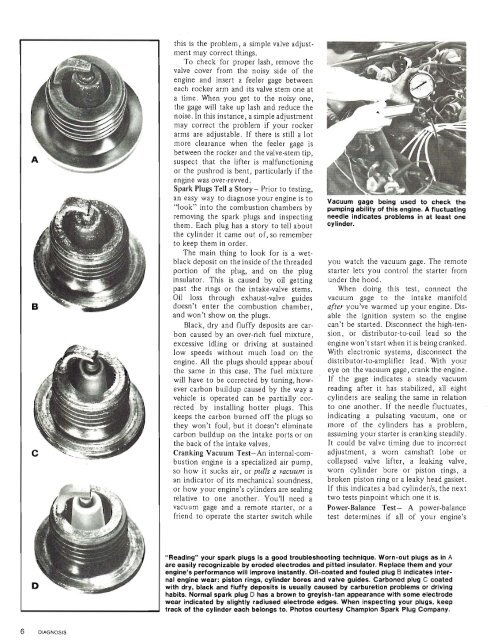How To Rebuild Your Ford V-8 351C-351M-400-429-460.pdf - Index of
How To Rebuild Your Ford V-8 351C-351M-400-429-460.pdf - Index of
How To Rebuild Your Ford V-8 351C-351M-400-429-460.pdf - Index of
You also want an ePaper? Increase the reach of your titles
YUMPU automatically turns print PDFs into web optimized ePapers that Google loves.
I<br />
-<br />
this is the problem, a simple valve adjustment<br />
may correct things. w<br />
<strong>To</strong> check for proper lash, remove the<br />
,*<br />
-ye<br />
valve cover from the noisy side <strong>of</strong> the<br />
engine and insert a feeler gage between<br />
each rocker arm and its valve stem one at<br />
a time. When you get to the noisy one,<br />
ci<br />
pir7<br />
the gage will take up lash and reduce the<br />
noise. In this instance, a simple adjustment<br />
may correct the problem if your rocker<br />
arms are adjustable. If there is still a lot<br />
more clearance when the feeler gage is<br />
-<br />
between the rocker and the valve-stem tip,<br />
suspect that the lifter is malfunctioning<br />
or the pushrod is bent, particularly if the<br />
engine was over-rewed.<br />
Spark Plugs Tell a Story- Prior to testing,<br />
an easy way to your engine is<br />
Vacuu, gage being u=, to check the<br />
"look" into the combustion chambers by pumping ability <strong>of</strong> this engine. A fluctuating<br />
removing the spark plugs and inspecting needle indicates problems in at least one<br />
them. Each plug has a story to tell about cylinder.<br />
the cylinder it came out <strong>of</strong>, so remember<br />
to keep them in order.<br />
The main thing to look for is a wetblack<br />
deposit on the inside <strong>of</strong> the threaded you watch the vacuum gage. The remote<br />
portion <strong>of</strong> the plug, and on the plug starter lets you control the starter from<br />
insulator. This is caused by oil getting under the hood.<br />
past the rings or the intake-valve stems. When doing this test, connect the<br />
Oil loss through exhaust-valve guides vacuum gage to the intake manifold<br />
doesn't enter the combustion chamber, after you've warmed up your engine. Disand<br />
won't show on the plugs.<br />
able the ignition system so the engine<br />
Black, dry and fluffy deposits are car- can't be started. Disconnect the high-tenban<br />
caused by an over-rich fuel mixture, sion, or distributor-to-coil lead so the<br />
excessive idling or driving at sustained engine won't start when it is beingcranked.<br />
low speeds without much load on the With electronic systems, disconnect the<br />
engine. pJ the plugs should appear aboui distributor-to-amplifier lead. .With your<br />
the same in this case. The fuel mixture eye on the vacuum gage, crank the engine.<br />
wdl have to be corrected by tuning, how- If the gage indicates a steady vacuum<br />
ever carbon buildup caused by the way a reading after it has stabilized, all eight<br />
vehicle is operated can .be partially tor- cylinders are seal@g the same in relation<br />
rected by installing hotter plugs. This to one another. ~f the needle fluctuates,<br />
keeps the carbon burned <strong>of</strong>f the plugs so indicating a pulsating vacuum, one or<br />
they won't foul, but it doesn't eliminate more <strong>of</strong> the cylinders has a problem,<br />
carbon buildup on the intake ports or on assuming your starter is cranking steadily.<br />
the back <strong>of</strong> the intake valves.<br />
It could be valve timing due to incorrect<br />
Cranking Vacuum Test-An internal-~om- adjustment, a worn camshaft lobe or<br />
bustion engine is a specialized air pump, collapsed valve lifter, a leaking valve,<br />
so how it sucks air, or pulls a vacuum is worn cylinder bore or piston rings, a<br />
an indicator <strong>of</strong> its mechanical soundness, broken piston ring or a leaky head gasket.<br />
or how your engine's cylinders are sealing If this indicates a bad cylinderls, the next<br />
relative to one another. You'll need a two tests pinpoint which one it is.<br />
vacuum gage and a remote starter, or a Power-Balance Test- A power-balance<br />
friend to operate the starter switch while test determines if all <strong>of</strong> your engine's<br />
"Reading" your spark plugs is a good troubleshooting technique. Worn-out plugs as in A<br />
are easily recognizable by eroded electrodes and pitted insulator. Replace them and your<br />
engine's performance wlll Improve instantly. Oil-coated and fouled plug B indicates internal<br />
engine wear: piston rings, cylinder bores and valve guides. Carboned plug C coated<br />
with dry, black and fluffy deposits is usually caused by carburetion problems or driving<br />
habits. Normal spark plug D has a brown to greyish-tan appearance with some electrode<br />
wear indicated by slightly radiused electrode edges. When inspecting your plugs, keep<br />
track <strong>of</strong> the cylinder each belongs to. Photos courtesy Champion Spark Plug Company.
















